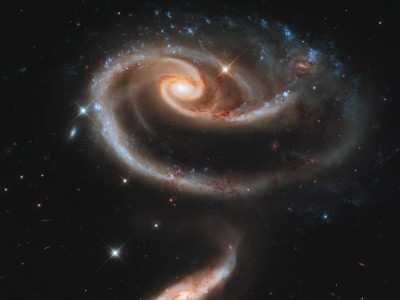Space Telescope Takes Its Own Birthday Picture
To celebrate the 21st anniversary of the Hubble Space
Telescope's deployment into space, astronomers at the Space
Telescope Science Institute in Baltimore pointed Hubble's eye at an
especially photogenic pair of interacting galaxies called Arp 273.
"For 21 years, Hubble has profoundly changed our view of the
universe, allowing us to see deep into the past while opening our
eyes to the majesty and wonders around us," NASA Administrator
Charles Bolden said. "I was privileged to pilot space shuttle
Discovery as it deployed Hubble. After all this time, new Hubble
images still inspire awe and are a testament to the extraordinary
work of the many people behind the world's most famous
observatory."

Hubble's Birthday "Rose"
Hubble was launched April 24, 1990, aboard Discovery's STS-31
mission. Hubble discoveries revolutionized nearly all areas of
current astronomical research from planetary science to
cosmology.
"Hubble is America's gift to the world," Sen. Barbara Mikulski
of Maryland said. "Its jaw-dropping images have rewritten the
textbooks and inspired generations of schoolchildren to study math
and science. It has been documenting the history of our universe
for 21 years. Thanks to the daring of our brave astronauts, a
successful servicing mission in 2009 gave Hubble new life. I look
forward to Hubble's amazing images and inspiring discoveries for
years to come."
The newly released Hubble image shows a large spiral galaxy,
known as UGC 1810, with a disk that is distorted into a rose-like
shape by the gravitational tidal pull of the companion galaxy below
it, known as UGC 1813. A swath of blue jewel-like points across the
top is the combined light from clusters of intensely bright and hot
young blue stars. These massive stars glow fiercely in ultraviolet
light. The smaller, nearly edge-on companion shows distinct signs
of intense star formation at its nucleus, perhaps triggered by the
encounter with the companion galaxy.

Arp 273 lies in the constellation Andromeda and is roughly 300
million light-years away from Earth. The image shows a tenuous
tidal bridge of material between the two galaxies that are
separated from each other by tens of thousands of light-years.
A series of uncommon spiral patterns in the large galaxy are a
tell-tale sign of interaction. The large, outer arm appears
partially as a ring, a feature seen when interacting galaxies
actually pass through one another. This suggests the smaller
companion dived deep, but off-center, through UGC 1810. The inner
set of spiral arms is highly warped out of the plane, with one of
the arms going behind the bulge and coming back out the other side.
How these two spiral patterns connect is not precisely known.
The larger galaxy in the UGC 1810 - UGC 1813 pair has a mass
about five times that of the smaller galaxy. In unequal pairs such
as this, the relatively rapid passage of a companion galaxy
produces the lopsided or asymmetric structure in the main spiral.
Also in such encounters, the starburst activity typically begins in
the minor galaxies earlier than in the major galaxies. These
effects could be because the smaller galaxies have consumed less of
the gas present in their nuclei, from which new stars are born.
The interaction was imaged on Dec. 17, 2010, with Hubble's Wide
Field Camera 3 (WFC3). The picture is a composite of data taken
with three separate filters on WFC3 that allow a broad range of
wavelengths covering the ultraviolet, blue, and red portions of the
spectrum.
 ANN's Daily Aero-Linx (04.16.24)
ANN's Daily Aero-Linx (04.16.24) Aero-News: Quote of the Day (04.16.24)
Aero-News: Quote of the Day (04.16.24) Airborne 04.10.24: SnF24!, A50 Heritage Reveal, HeliCycle!, Montaer MC-01
Airborne 04.10.24: SnF24!, A50 Heritage Reveal, HeliCycle!, Montaer MC-01 Airborne 04.12.24: SnF24!, G100UL Is Here, Holy Micro, Plane Tags
Airborne 04.12.24: SnF24!, G100UL Is Here, Holy Micro, Plane Tags Airborne-Flight Training 04.17.24: Feds Need Controllers, Spirit Delay, Redbird
Airborne-Flight Training 04.17.24: Feds Need Controllers, Spirit Delay, Redbird




